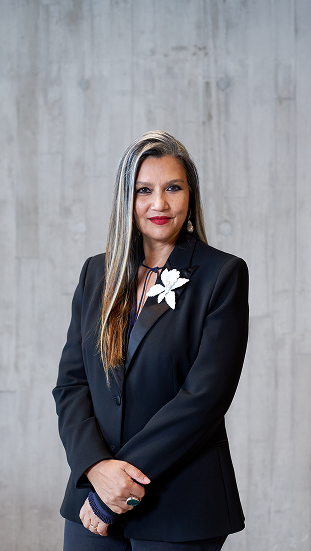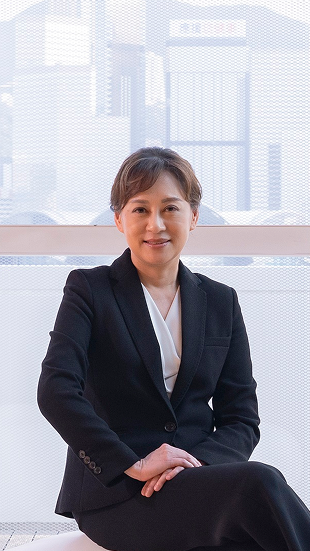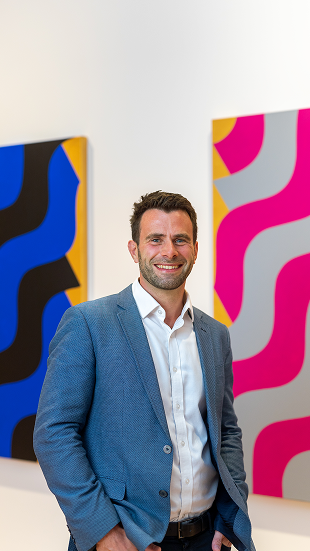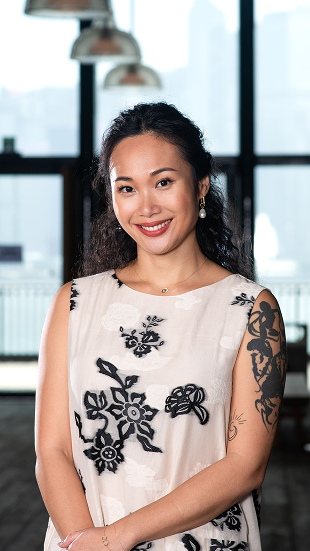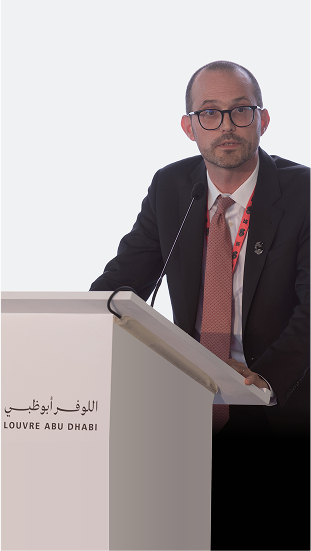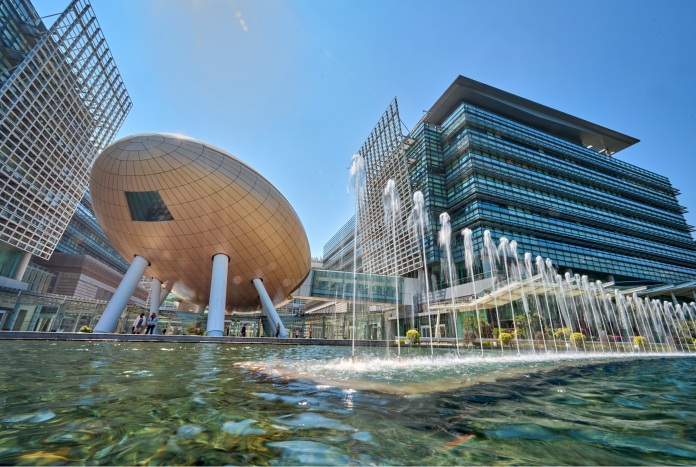Hong Kong: A Global
Hub for Creativity
Hong Kong: A
Global Hub for
Creativity
strategic location, and top-class transport infrastructure make Hong Kong
one of the global hubs for art and culture
cultural institutions, strategic location, and
top-class transport infrastructure make Hong Kong
one of the global hubs for art and culture
Spring is a season for art in Hong Kong. More than 100 events were held in March this year, with highlights ranging from Art Basel Hong Kong and the tenth edition of Art Central to the HKWALLS Street Art Festival.
As the colourful Chinese New Year celebrations subside, the month of March offers yet more evidence of the city’s cosmopolitan character and cultural richness.
"There is a significant uptick as soon as everyone comes back from the New Year (break), which is pretty cool. The city is buzzing," says Angelle Siyang-Le, Director of Art Basel Hong Kong.
It is a scene that is constantly evolving, with new institutions being set up, initiatives launched and businesses established.
One relatively recent addition to the city's cultural scene is M+, which opened in 2021 and focuses on 20th and 21st century visual culture. In less than four years, it has attracted more than eight million visitors from around the world.
“Hong Kong has transformed into a true global arts hub over the past ten years,” says Suhanya Raffel, Museum Director of M+. “It has become a much more international city in terms of the arts scene by growing a strong arts ecology.”
CULTURAL EXCHANGE
One reason Hong Kong has proven such a draw has been its ability to connect with the surrounding region and beyond, attracting collectors, galleries and artists, as well as all the underlying services needed for an art scene to thrive – something that fits in with the government’s aim to make the city a hub of East-meets-West cultural exchange.
An example of those connections was an exhibition that opened in M+ on March 15, featuring more than 60 works by the Spanish master Pablo Picasso on loan from the Musée national Picasso-Paris (MnPP).
These hang alongside about 130 works by Asian and Asian-diasporic artists from M+’s own collection.
“This is the first time masterpieces from the MnPP are shown in dialogue with a museum collection in Asia, and the audience can examine Picasso’s enduring influence in, and connections with, Asia,” explains Raffel.
M+ sits in the West Kowloon Cultural District (WestK), alongside the Hong Kong Palace Museum and an 11-hectare Art Park. The district, which will also house the upcoming WestK Performing Arts Centre, was set up by the government to be a cultural hub in the heart of the city.
Hong Kong has transformed into a true global arts hub over the past 10 years. It has become a much more international city in terms of the arts scene by growing a strong arts ecology.
M+ sits in the West Kowloon Cultural District (WestK), alongside the Hong Kong Palace Museum and an 11-hectare Art Park. The district, which will also house the upcoming WestK Performing Arts Centre, was set up by the government to be a cultural hub in the heart of the city.
GROWTH
This is not just about providing entertainment and cultural diversion for locals and visitors though. There is an important economic element to the city's arts scene too. According to 2022 figures, the cultural and creative industries added HK$122 billion (Dh57.6 billion) a year to the city's economy and provided more than 220,000 jobs. In 2023, the total trade value of works of art, collectors' pieces and antiques exceeded HK$100 billion (Dh46.7 billion), making Hong Kong one of the world's top three art trading centres. These numbers have been growing steadily over time, as the city's arts and cultural scene has developed.
“When we first came to Hong Kong in 2013, we had the auction houses and the international galleries but there weren't many institutions, let alone the world-class institutions,” says Art Basel Hong Kong’s Siyang-Le. “Today you can see quite a comprehensive art ecosystem in Hong Kong, which is having quite a significant impact.”
The city’s older institutions have also witnessed these changes, including the Hong Kong Museum of Art, which has been at the centre of the city’s cultural life since 1962. “We are the first public art museum in town,” says Museum Director Dr Maria Mok.
We put a lot of emphasis on how to bring out the Hong Kong DNA in our curation and in our exhibitions so that people would enjoy that heritage, but also at the same time feel that art is connected to them.
“We have established ourselves as the custodian of the art legacy of Hong Kong.”
It opened in a relatively small venue in City Hall on Hong Kong Island, but moved to its current site in Kowloon in 1991, with ten times more space. Then, after a major renovation, it reopened in 2019.
“We want to showcase the best of Hong Kong art to the world but, at the same time, we are doing a lot of rethinking as to what we mean to our city,” adds Mok. “After the renovation, we repositioned ourselves. We put a lot of emphasis on how to bring out the Hong Kong DNA in our curation and in our exhibitions, so that people would enjoy that heritage, but also at the same time feel that art is connected to them.”
“We want to showcase the best of Hong Kong art to the world but, at the same time, we are doing a lot of rethinking as to what we mean to our city,” adds Mok. “After the renovation, we repositioned ourselves. We put a lot of emphasis on how to bring out the Hong Kong DNA in our curation and in our exhibitions, so that people would enjoy that heritage, but also at the same time feel that art is connected to them.”
Economic contribution of Hong Kong's cultural and creative industries
Contribution to Hong Kong's GDP from the cultural and creative industries
Employment impact a year
Number of exhibitors that are participating at this year’s Art Basel Hong Kong
GLOBAL REACH
Hong Kong is really a global city, so you're getting people from around East Asia and Southeast Asia and from as far afield as Australia.
The combination of global and local connections is the lifeblood of a cultural hub. During the Hong Kong International Cultural Summit 2024, the West Kowloon Cultural District Authority oversaw the signing of 21 memoranda of understanding (MoUs) between Hong Kong art institutions and their peers around the world.
They included MoUs between the Hong Kong Palace Museum and the Tokyo National Museum in Japan and Qatar Museum, and between M+ and the Centre Pompidou in Paris and the UAE’s Sharjah Art Foundation.
Others from the UAE have also been drawn to the city, such as Dubai’s Lawrie Shabibi art gallery, which is a regular exhibitor at Art Basel Hong Kong.
Others from the UAE have also been drawn to the city, such as Dubai’s Lawrie Shabibi art gallery, which is a regular exhibitor at Art Basel Hong Kong.
“Hong Kong is really a global city, so you're getting people from around East Asia and Southeast Asia and from as far afield as Australia,” says William Lawrie, co-founder of the gallery. “For us, what's most exciting is the regional collectors and institutions.”
Lawrie Shabibi is one of 240 exhibitors from 42 countries and territories that are showing at this year’s Art Basel Hong Kong. Among the key elements that underpin the appeal of that show – and of Hong Kong more generally – are the city’s strong links to Mainland China.
"Hong Kong is strategically positioned as a cultural hub because of the benefits that we receive, such as the tax-free status of the city, as well as the geographic advantage. Being a very convenient transport hub also helps. And going into Mainland China from Hong Kong is very, very easy,” says Siyang-Le.
Hong Kong is strategically positioned as a cultural hub because of the benefits that we receive, such as the tax-free status of the city, as well as the geographic advantage.
THAT POWERS
The strength of the city's infrastructure is something other art market participants also value. “Hong Kong is a kind of regional hub in a way that few other places in that region really are. Part of it is because it's easier to do business there. It's easier to ship things in and out. Practicality-wise, it's the easiest place to do it,” says Lawrie.
Cities around the world are striving to establish themselves as cultural powerhouses, aiming to compete with traditional art capitals that have long dominated the global scene.
“Cities with the transport infrastructure, the legal infrastructure, the economic infrastructure are playing the role of a hub,” says Manuel Rabaté, Director of Louvre Abu Dhabi. “Cities like New York or Paris or London already have a very mature system. What is stimulating in Abu Dhabi and I'm sure in Hong Kong is it's a transformation.”
Cities like New York or Paris or London already have a very mature system. What is stimulating in Abu Dhabi and I'm sure in Hong Kong is it's a transformation.
For that to happen requires committed support from public authorities. The investment being poured into cultural institutions is what allows cities to cement and develop their status and compete on a global stage.
“The public sector cannot do everything, but the investments in infrastructure allow the private sector to thrive and develop and grow,” he adds.
Part of thriving is recognising and celebrating where art may go next. “In an era of rapid technological development, the convergence of creativity and innovation has led to transformative changes in how art and design are created, presented, and understood,” says M+’s Raffel.
Cities like New York or Paris or London already have a very mature system. What is stimulating in Abu Dhabi and I'm sure in Hong Kong is it's a transformation.
Part of thriving is recognising and celebrating where art may go next. “In an era of rapid technological development, the convergence of creativity and innovation has led to transformative changes in how art and design are created, presented, and understood,” says M+’s Raffel.
THE FUTURE
Hong Kong’s cultural scene is responding to these changes, with institutions opening themselves up to the next generation of artists.
“Since our reopening, we have been commissioning Hong Kong artists in almost all of our exhibitions,” says Hong Kong Museum of Art’s Mok. “We are very aware of the ever-changing world of technology and we take it very seriously. The way we deal with it is that we collaborate with artists and we leverage their expertise through commissioning. Our expertise is in art history, in curation, but we have a large family of artists who are experts in experimenting with new media and technology and that's why the collaboration with them is very, very important.”
This creates an environment that is appealing, not only to Hong Kongers but also to people from much further afield.
“Artists love to be able to show in different venues, especially one that has very rich and quite varied visual traditions,” says Lawrie. “There've always been links between different parts of Asia and I think that's really exciting. For us, particularly with Emirati artists that are central to our programme, to be able to show their work in places like Hong Kong is really where we're adding our value as a gallery. It’s a wonderful thing for us to be able to do.”
